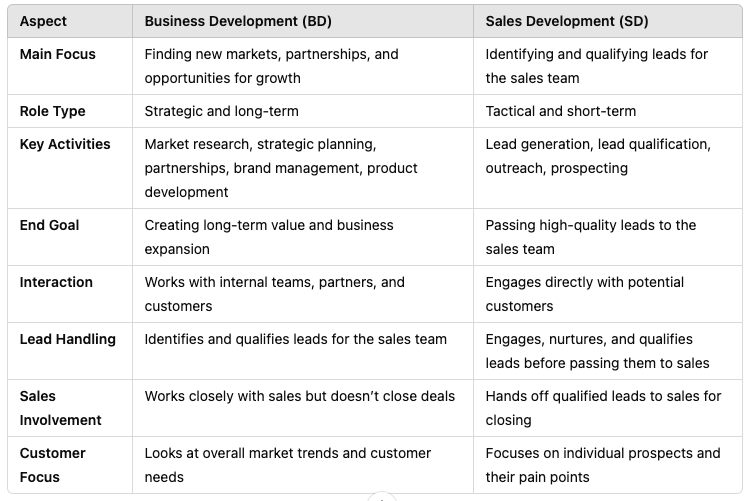Business development and sales development might seem similar, but they’re not the same. Smaller companies and startups might combine these roles, but more established businesses usually hire separate reps for each.
Both aim to deliver your solution to customers, but they work as separate, complementary parts rather than a single entity. Not having both roles clearly defined in your operations could dampen the full potential of your sales efforts in the long run.
This article breaks down the differences between business development and sales development, how they overlap, and why you need both to succeed.
What is Business Development?
Business development (biz dev) is about finding new markets, fostering partnerships, and qualifying leads to grow your business and increase revenue. It’s a strategic role focused on creating long-term value through smart strategies and opportunities.
Business development reps (BDRs) don’t just offer quick fixes. They focus on understanding their company’s product, the market, and emerging trends and provide informed advice.
The process involves taking clear steps to drive that growth forward, including:
- Strategic Planning: Creating long-term plans that align with your company’s goals and vision.
- Exploring New Markets: Researching and entering new markets, whether by geography or customer demographics.
- Building Partnerships: Building relationships with businesses, suppliers, or distributors to identify new growth opportunities.
- Brand Management and Marketing: Running impactful campaigns, managing channels, and using digital marketing to build your brand.
- Sales and Lead Generation: Finding and qualifying leads, then working with your sales development team to turn those leads into loyal customers.
- Product Development and Innovation: Use customer feedback and team collaboration to create new products and improve existing ones.
- Managing Customer Relationships: Increasing satisfaction with loyalty programs, retention strategies, and regular feedback collection.
What is Sales Development?
Sales development kicks off the sales process. It’s not about closing deals—that’s the sales team’s job. Instead, sales development reps (SDRs) find leads, qualify them, and pass them on using strategies like lead scoring and lead distribution. The focus is on narrowing down high-quality prospects.
SDRs handle warmed-up inbound leads but also conduct cold email and cold call outreach. They should have a deep understanding of their product and be able to connect it to the prospect’s pain points. They answer questions, address doubts, and make sure only the best leads reach the sales team.
With that settled, let’s break down the differences between business and sales development.
Business Development vs. Sales Development: Differences Unpacked
BDRs focus on big-picture efforts like exploring new markets, building business connections, and finding new leads. In contrast, SDRs work directly with leads, qualifying them and moving them through the sales funnel.
Here’s a quick summary of their roles:

Why Keep Business and Sales Development Separate?
Why separate business and sales development in your operations? Here are a few reasons to:
Improved Focus
As mentioned, business development reps qualify leads and identify growth opportunities. Sales development reps, on the other hand, focus on sales prospecting and setting up meetings to move leads further down the pipeline.
Trying to juggle all these responsibilities into one team can lead to wasted time and missed opportunities. By separating tasks, each team can fully focus on one priority instead of splitting their time between two demanding goals.
More Strategic Approach
BDRs need to understand the prospect’s business and industry as a whole. For them, strong advisory and research skills are a must. Meanwhile, SDRs should be more skilled in building rapport, qualifying leads, and handling objections to drive meaningful conversations and set their teams up for success.
Hiring separate people for business and sales development lets companies leverage specialized skills. This helps improve each step of the sales process and creates a more strategic approach to growth.
Increased effectiveness
Reaching buyers is now more difficult than ever. It takes more effort, research, and interaction to make a connection. Today’s buyers want to feel understood before engaging with a sales team. A strong business development team bridges this gap, helping you build that understanding and connect faster.
How Business and Sales Development Work Together
The goals of both business development and sales development sit between marketing and sales. In companies with separate BD and SD departments, leads move from marketing to business development, then to sales development, and finally to sales before becoming customers.
Biz dev and sales dev teams share the same goal: finding new customers, closing deals, and boosting revenue. When they work together, they create consistent growth and long-term success. Here’s how these roles can team up to drive better results for your sales efforts:
The Essential Overlap Between BD and SD
Business development and sales development need to work together. Overlapping their efforts ensures leads don’t slip through the cracks and opportunities aren’t missed.
When teams work together, they can align on what makes a good lead, keep messaging consistent, and communicate more effectively. Regular check-ins, shared tools, and open communication make this process smoother, leading to higher-quality leads and a faster sales cycle.
When teams structure business development as the first point of contact and hand it off to sales reps later, the focus shifts. Instead of relying on personal preferences, the team works together toward shared company goals.
When Business Development Should Hand Off Leads to Sales Development

A BDR identifies your ideal customers, figures out where to find them, and kicks off lead generation. Once a lead fits your customer profile and shows real interest, they’re passed to sales development to take it from there.
The goal is simple: save time and focus your sales team on leads that matter. To make it work, both teams need to agree on what qualifies a lead for sales and clearly define your ideal customer. Alignment is key.
Growing Your Business: Do You Need to Hire a BDR or SDR?
Scaling your business starts with hiring the right people. Wondering if you need a business development rep or a sales development rep? It all comes down to your goals, target market, and sales strategy.
Here’s how to decide which role fits your needs:
- Evaluating Your Game Plan for Growth: If you're looking to expand into new markets or build partnerships, a BDR is your go-to. They focus on long-term opportunities that grow your business. Need more qualified leads in your sales pipeline? That’s where an SDR comes in—they’ll handle prospecting and customer outreach.
- Understanding Your Sales Cycle: For longer, more complex sales cycles, hiring both BDRs and SDRs is a smart move. BDRs focus on big opportunities that take time, while SDRs keep a steady flow of leads coming in. For shorter, fast-paced sales cycles, an SDR might be all you need to close deals quickly.
- Aligning With Your Team’s Needs: If your sales team is struggling with unqualified leads, an SDR can filter them out so your sales team can focus on high-potential deals. If you need new growth opportunities, a BDR can build strategic partnerships and explore untapped markets.
The right choice depends on your business’s stage, industry, and goals. Often, having both roles leads to better growth, more leads, and higher revenue.
How Instantly.ai Supports Business and Sales Development

Instantly.ai is a powerful sales and marketing partner for both BDRs and SDRs, thanks to features that help streamline outreach, increase engagement, and improve lead generation.
For business development, Instantly ensures that email campaigns have the highest chance of success. Its AI-powered email warm-up improves deliverability and keeps your messages out of spam. This means your outreach to potential partners, investors, or new markets lands where it matters most—directly in inboxes.
For sales development, Instantly makes prospecting easier by allowing SDRs to manage email lists, create personalized campaigns, and automate follow-ups. Smart segmentation and personalization help send messages that connect with prospects, increasing response rates.
Plus, automated email sequences handle lead nurturing without extra effort. Both teams benefit from comprehensive analytics, which tracks engagement and campaign performance. This helps reps improve strategies and focus on what works. Whether you're building partnerships or growing your sales pipeline, Instantly makes it quicker and easier.
Key Takeaways
Business development and sales development may sound similar, but they’re completely different roles. Understanding their differences and how they work together can help you grow smarter and faster.
To recap:
- BDRs focus on long-term growth by finding new markets, building partnerships, and driving lead generation. SDRs focus on qualifying leads and moving them through the sales funnel. Both roles drive revenue, but they do so in different ways and on different timelines.
- Business development lays the groundwork by finding opportunities and warming up leads. SD turns those leads into prospects ready to convert. When these teams work together, they create a seamless pipeline that results in higher-quality leads and better sales outcomes.
- Looking to grow your business? Hire a BDR to focus on long-term market expansion. Need more qualified leads for your sales team? Bring in an SDR. Many businesses find success by combining both roles for steady growth and quick wins.
Instantly simplifies both business and sales development by automating email outreach, boosting deliverability, and improving lead engagement, helping you turn prospects into customers faster. Try it for free today.





